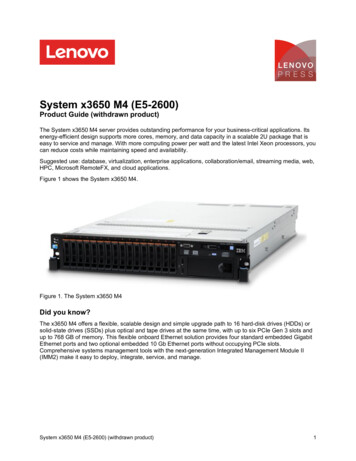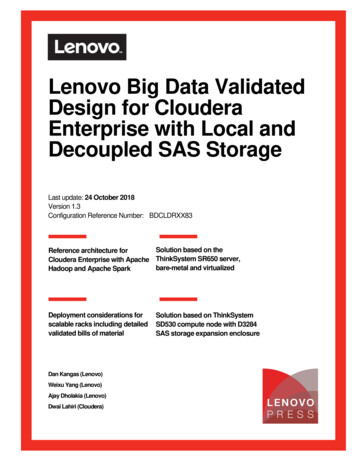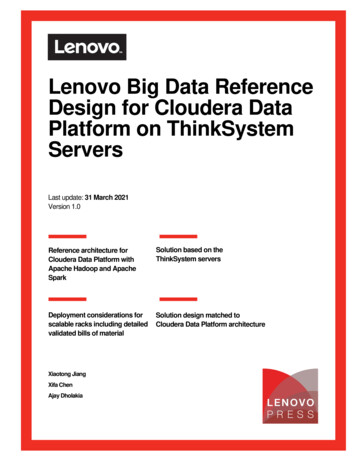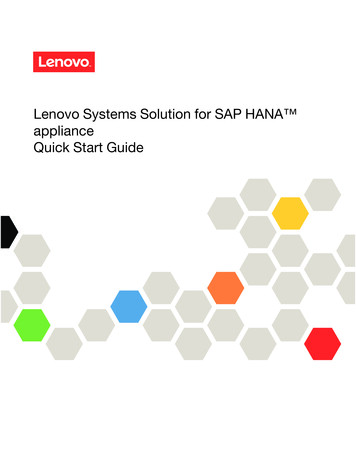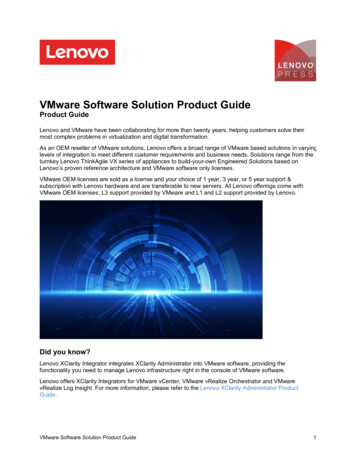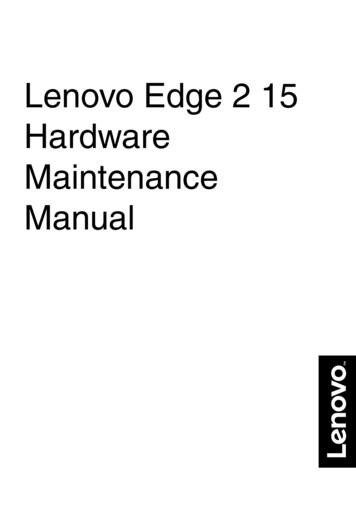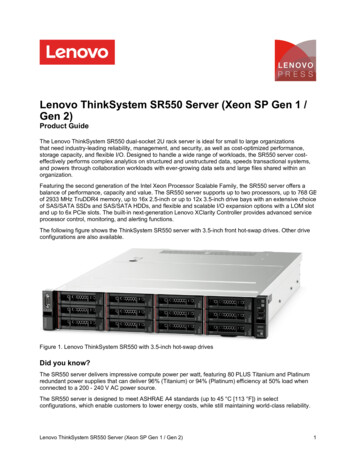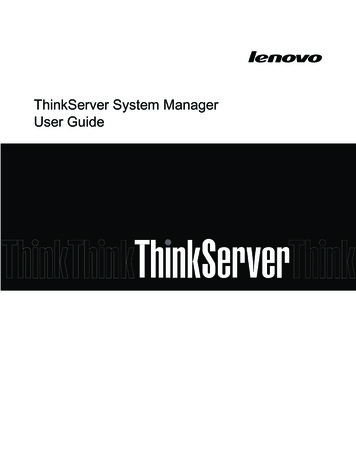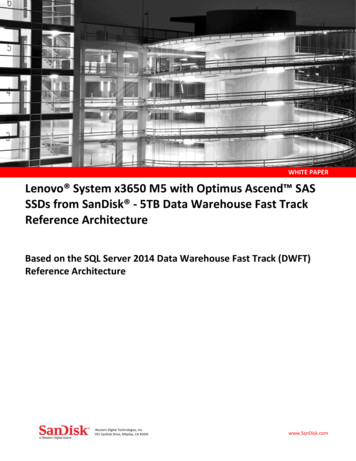
Transcription
WHITE PAPERLenovo System x3650 M5 with Optimus Ascend SASSSDs from SanDisk - 5TB Data Warehouse Fast TrackReference ArchitectureBased on the SQL Server 2014 Data Warehouse Fast Track (DWFT)Reference ArchitectureWestern Digital Technologies, Inc.951 SanDisk Drive, Milpitas, CA 95035www.SanDisk.com
Lenovo System x3650 with Optimus Ascend SSDs from SanDisk – Data Warehouse Fast Track Reference ArchitectureTable of ContentsExecutive Summary.3About the Lenovo System x3650 M5 .3Optimus Product Family of SAS SSDs .3Guardian Technology Platform .4New Data Warehouse Features in Microsoft SQL Server 2014. .4About the Data Warehouse Fast Track Reference Architecture .4Reference Architecture .5General Settings .5Operating System Settings .5Windows Configuration – Power Settings .5Storage Configuration.6UEFI Configuration.6Database Configuration .6TempDB Configuration .6Memory Allocation .6Local Security Policy .6SQL Server 2014 Configuration Parameters .7Measured Performance.7SQL Server Data Warehouse Fast Track Certification .8Summary .9Bill of Materials .9Lenovo System x3650 M5 .92
Lenovo System x3650 with Optimus Ascend SSDs from SanDisk – Data Warehouse Fast Track Reference ArchitectureExecutive SummaryThis guide details the server, storage and software configurations for the Lenovo System x3650 M5 withOptimus Ascend SSDs from SanDisk (6Gb/s SAS, 400GB), which Microsoft has validated for a Fast Track-rateduser data capacity of 5TB.By installing a single CPU in this 2-socket system, and with 18 small form factor (SFF) drive bays unused, this 5TBarchitecture offers scalable capacity and performance while minimizing software licensing costs.This document is for individuals (BI architects, DBAs, report developers, and IT directors) involved in decisionmaking who are looking for guidance when designing enterprise, business-intelligence applications.The Microsoft SQL Server Data Warehouse Fast Track (DWFT) Reference Architecture is designed to eliminatethe complexity of properly sizing hardware, which helps reduce unnecessary scale-out of storage and servers.The sizing techniques used in the SQL Server DWFT will properly size servers based on I/O and CPUconsumption. This consumption-based approach ensures your data warehouse can fully take advantage of yourhardware investment.About the Lenovo System x3650 M5With the powerful, versatile new 2U two-socket Lenovo System x3650 M5 rack server, you can run even moreworkloads, 24 x 7, and gain faster business insights. Integrated with the Intel Xeon processor E5-2600 v3product family and industry-leading two-socket storage capacity, the x3650 M5 fast-forwards your business. Youcan select from an impressive array of storage configurations (up to 28 small form factor [SFF] drive bays) thatoptimize diverse workloads from cloud to big data.Combining balanced performance and flexibility, the x3650 M5 is a great choice for small and mediumbusinesses up to the large enterprise. It can provide outstanding uptime to keep business-critical applicationsand cloud deployments running safely. Ease of use and comprehensive systems management tools help makedeployment easier. Outstanding reliability, availability, and serviceability (RAS) and high-efficiency designimprove your business environment and help save operational em-x3650-m5Optimus Product Family of SAS SSDsAvailable in capacities of 100GB – 2TB, Optimus SAS SSDs from SanDisk provide Random read performance up to 95K IOPS Random write performance up to 40K IOPS3
Lenovo System x3650 with Optimus Ascend SSDs from SanDisk – Data Warehouse Fast Track Reference Architecture Sequential read data transfer up to 550MB/s Sequential write data transfer up to 540MB/sThe Optimus SAS SSD portfolio has been designed to offer a range of performance and capacity solutions for avariety of applications that include mixed-use, read-intensive, and write-intensive workloads. Optimus SAS SSDsrange from one to 45 full random drive writes per day (DWPD). The Optimus SAS SSD has a five-year warranty.For more information on Optimus SAS SSDs, refer to the product isk-main/en sas-ssd-product-family-datasheet.pdfGuardian Technology PlatformThe Optimus SAS SSD product family is powered by SanDisk’s proprietary Guardian Technology Platform, acomprehensive suite of enterprise features comprised of FlashGuard , DataGuard and EverGuard technologies. FlashGuard Technology combines Aggregated Flash Management, which treats all flash elements as asingle system, and Advanced Signal Processing. The Advanced Signal Processing feature dynamicallyadjusts flash parameters throughout the life of the SSD, to reliably extract significantly more life fromcommercial-grade MLC flash. This makes it suitable for mixed-use, read-intensive, and write-intensiveapplication workloads. DataGuard Technology features full data path protection, safeguarding user data from corruption alongall data paths in the SSD. EverGuard Technology protects against loss of user data in the event of unexpected powerinterruptions. It uses a third-generation backup power circuit design and high-reliability discretecapacitors. Optimus SAS SSDs are designed for I/O intensive, mission-critical, 24/7 applications.IT managers, database architects, and CTOs looking to explore and deploy data warehouses and BI applicationsnow have added leverage – they can take advantage of the Optimus SAS SSD’s engineering, integration, andoptimization to quickly build and deploy their next data warehouses.New Data Warehouse Features in Microsoft SQL Server 2014.Microsoft added clustered column store indexes (CCI) in SQL Server 2014, which are designed to decrease queryresponse times and deliver deeper levels of data compression. CCI technology eliminates the need to buildsummary tables, thus further reducing ETL run times. CCI is optimized for query performance. Our solutions deliver 7x better query performance when usingCCI. The CCI solution accomplishes this by using a columnar format to compress the data by 10x ormore, processing a set of rows in batches and reading only the columns that are referenced in thequery. CCI is updateable, allowing concurrent insert – both bulk import and trickle – of new data while thequery workload is running. This reduces the data latency from the time data is born to when it isavailable for querying.About the Data Warehouse Fast Track Reference ArchitectureThe SQL Server Data Warehouse Fast Track reference architecture provides a scalable framework, based onbalancing I/O to achieve maximum performance from SMP-based servers. The SQL Server Data Warehouse Fast4
Lenovo System x3650 with Optimus Ascend SSDs from SanDisk – Data Warehouse Fast Track Reference ArchitectureTrack eliminates the complexity of sizing servers with data warehouses by providing data consumption rates thatproperly balance performance between the disk subsystem, CPU, and memory.More information on SQL Server DWFT can be found ata-warehouse-fast-track.aspxReference ArchitectureThe following table shows the configuration details for the Optimus Ascend 5TB Fast Track Data Warehouse.ServerLenovo System x3650 M5Operating SystemMicrosoft Windows Server 2012 R2 Standard EditionCPUIntel Xeon E5-2620 v3 (single-socket)Primary Data Drives8 x 400GB Optimus Ascend SAS SSDs from SanDisk (RAID 5)RAID ControllerServeRAID M5210 SAS/SATA ControllerOS Drives2 x 1TB SAS (Mirrored)RAM128GBGeneral SettingsOperating System SettingsThe operating system used for this Fast Track Data Warehouse test was Microsoft Windows Server 2012 R2Standard Edition. Standard installation steps were used to install the OS with default values, followed by servicepacks and update patches.Windows Configuration – Power SettingsThe High Performance plan was chosen to reduce CPU throttling, as shown below.5
Lenovo System x3650 with Optimus Ascend SSDs from SanDisk – Data Warehouse Fast Track Reference ArchitectureOptimus Ascend ConfigurationEach Optimus Ascend SAS SSD was attached to the ServeRAID M5210 Controller and configured as a single DriveGroup (RAID 5) set, with a single virtual drive presented to the Windows OS.ServeRAID M5210 ControllerThe ServeRAID M5210 SAS/SATA controller is a PCIe 3.0, half-size, half-height RAID controller based on theLSISAS3108 PCI Express-SAS/SATA I/O Processor chip.The controller controls eight internal SAS/SATA ports through two SFF-8643 4i internal mini-SAS HD connectors.The controller integrates eight high-performance SAS/SATA PHY chips and a PCI Express bus master DMA core.Each of the eight PHYs is capable of 12.0 Gb/s SAS link rates and 6.0 Gb/s SATA III link rates.Storage ConfigurationThe following configuration was chosen.SlotDeviceCapacityMount PointAllocationNotesN/AOptimus Ascend2.2TBC:\mounthead\Data Files\TempDB\LOGRAID 5N/ASAS HDD1.0TBC:\OSMirroredUEFI Configuration Hyper-threading was enabled. Memory mode was set to “Independent”. Operating mode was changed to "Maximum Performance”. Fan Offset was set to “Increased Cooling”.SQL Server Settings Database Configuration: A 1TB data warehouse schema was created for benchmarking using the FastTrack toolkit. The schema used a single primary filegroup (8 files). TempDB Configuration: In total, eight x 10GB tempdb files were created. Memory Allocation: SQL Server was allocated 118GB of the available server memory. Local Security Policy: The SQL Server maintenance account was granted the privileges of “Enable LockPages in Memory” and “Perform Volume Maintenance Tasks”.6
Lenovo System x3650 with Optimus Ascend SSDs from SanDisk – Data Warehouse Fast Track Reference ArchitectureSQL Server 2014 Configuration ParametersParameterSettingDescriptionMemory Allocation118GBThis is the Fast Track-required value for a 2-socket, 1 TBdatabase. Memory is deliberately constrained to enforce I/Opressure on the subsystem.Max Degree of Parallelism12When SQL Server runs on a computer with more than onemicroprocessor or CPU, it detects the best degree ofparallelism (the number of processors employed to run asingle statement).Resource Governormemory Allocation12%Default is 25%. This is reduced to 12% for both Row Store andColumn Store to reduce the maximum memory consumed perquery.Fast Track Required Startup Parameters-T1117-T1117 should be added to the startup options.Optional Trace FlagsNoneThis trace flag ensures even growth of all files in a file group incase autogrow is enabled. The standard FTDWrecommendation for database file growth is to pre-allocaterather than use autogrow (with the exception of tempdb).No additional Trace Flags were used.Measured PerformanceDuring Fast Track Database Validation, Microsoft’s Reference Point tool drives multiple concurrent queryworkloads designed to identify bottlenecks. The tool establishes the key performance metrics in the table below.Scan Rate TypeScan rateDescriptionRated User Capacity5TBRepresents the optimal Fast Track-certified data capacity of theconfiguration.Allows for 5:1 compression, recommended free space andapplies some memory and throughput based limits.Row Store Relative Throughput46Percentage throughput of this configuration in comparison tothe FTDW reference configuration. The reference configurationvalue is 100, but this is achieved with both sockets populated.Column Store Relative Throughput62Percentage throughput of this configuration in comparison tothe FTDW reference configuration. The reference configurationvalue is 100, but this is achieved with both sockets populated.Maximum User Data Capacity8TBCalculated based on total disk capacity and allows 5:1compression. Factors recommended free space and ignores thethroughput limits that are applied to the Rated User Capacity.Measured Throughput (Q/Hr/TB)49Number of combined benchmark queries completed during themeasurement interval. Normalized to the 1 TB database.7
Lenovo System x3650 with Optimus Ascend SSDs from SanDisk – Data Warehouse Fast Track Reference ArchitectureSQL Server Data Warehouse Fast Track Certification8
Lenovo System x3650 with Optimus Ascend SSDs from SanDisk – Data Warehouse Fast Track Reference ArchitectureSummaryTogether, Lenovo and SanDisk dedicated hundreds of hours of testing to engineer this SQL Server DWFT solutionto provide optimal reliability and performance. These series of tests pushed the Lenovo System x3650 M5 topeak performance without hardware failure. The reliability and performance experienced during testing is whatcan be expected in production environments.The same configuration meets the need of both Row Store and Column Store configurations, delivering highphysical read throughput in the Row Store configuration at 1.3GB/s, and high query rates in the Column Storeconfiguration at 402 Q/Hr/TB.The Lenovo System x3650 M5 with Optimus Ascend SAS SSD technology from SanDisk delivers superbperformance, with the ability to host larger data warehouses or consolidate multiple data warehouses.Bill of MaterialsLenovo System x3650 M5QtySKUDescription15462AC16coreTopSeller: Lenovo System x3650 M51A1MLIntegrated Management Module Advanced Upgrade2A5EUSystem x 750W High Efficiency Platinum AC Power Supply1A5GHSystem x3650 M5 Rear 2x 2.5" HDD Kit (Independent RAID)1A483Populate and Boot From Rear Drives1A5EYSystem Documentation and Software-US English1A5FVSystem x Enterprise Slides Kit1A5EASystem x3650 M5 Planar8A5B716GB TruDDR4 Memory (2Rx4, 1.2V) PC4-17000 CL15 2133MHz LP RDIMM1A5FHSystem x3650 M5 Agency Label GBM1A5FMSystem x3650 M5 System Level Code19206No Preload Specify1A4VHLightpath LCD Op Panel1A5FZSystem x3650 M5 Riser Filler2A5V6System x3650 M5 System Fan Filler1ASQASystem x3650 M5 Rear 2x 2.5" HDD Label (Independent RAID-Riser1)2A2HPConfiguration ID 019
Lenovo System x3650 with Optimus Ascend SSDs from SanDisk – Data Warehouse Fast Track Reference Architecture2A4ELHDD Filler ASM GEN 3 Quad Filler1A5FTSystem x3650 M5 Power Paddle Card1A5G1System x3650 M5 EIA Plate1A5H02U Bracket for Broadcom NetXtreme 2x10GbE BaseT Adapter1A5V4System x3650 M5 Right EIA1A5FCSystem x3650 M5 WW Packaging1A5G4System x3650 M5 ODD Filler1A5EDIntel Xeon Processor E5-2620 v3 6C 2.4GHz 15MB Cache 1866MHz 85W15977Select Storage devices - no configured RAID required1A5G6x3650 M5 8x 2.5" HS HDD Assembly Kit (Single RAID)1A3YZServeRAID M5210 SAS/SATA Controller1A45WServeRAID M1215 SAS/SATA Controller1A5FDSystem x3650 M5 2.5" Base without Power Supply1A5FYSystem x3650 M5 2.5" ODD/LCD Light Path Bay2A4TL300GB 10K 6Gbps SAS 2.5" G3HS HDD8A4UB400GB SAS 2.5" MLC G3HS Enterprise SSD1A5G3System x3650 M5 2.5" ODD Bezel with LCD Light Path1A5GZBroadcom NetXtreme 2x10GbE BaseT Adapter15374CM1HIPO : Configuration Instruction1A5M2ServeRAID M1215 SAS/SATA Controller Upgrade Placement1A2HPConfiguration ID 011A2JXController 0115374CM1HIPO : Configuration Instruction1A46PServeRAID M5210 SAS/SATA Controller Placement1A2HPConfiguration ID 011A2JYController 02Specifications are subject to change. 2016 Western Digital Corporation or its affiliates. All rights reserved. SanDisk and the SanDisk logo are trademarks of WesternDigital Corporation or its affiliates, registered in the U.S. and other countries. Optimus, Optimus Ascend, Guardian Technology, FlashGuard, DataGuard andEverGuard are trademarks of Western Digital Corporation or its affiliates. Other brand names mentioned herein are for identification purposes only and may be thetrademarks of their respective holder(s).5091EN 20160615Western Digital Technologies, Inc. is the seller of record and licensee in the Americas of SanDisk products.10
The controller controls eight internal SAS/SATA ports through two SFF-8643 4i internal mini-SAS HD connectors. The controller integrates eight high-performance SAS/SATA PHY chips and a PCI Express bus master DMA core. Each of the eight PHYs is capable of 12.0 Gb/s SAS link rates and 6.0 Gb/s SATA III link rates. Storage Configuration
